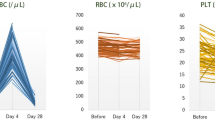Abstract
A “biosimilar” is a biotechnological product with a lower cost profile and equivalent efficacy and safety to the originator, but post-marketing clinical evaluation of biosimilar products has not been adequately conducted. We prospectively investigated the utility of biosimilar filgrastim in 13 peripheral blood stem cell (PBSC) donors from June 2014 to January 2017. In addition, we retrospectively compared these to another 13 PBSC donors mobilized with the originator filgrastim in the same period. Donor characteristics were equivalent between the groups. The median number of CD34+ cells per donor body weight (BW) and blood volume processed (BV) were 4.87 × 106/kg and 25.5 × 103/mL in the biosimilar group and 4.93 × 106/kg and 16.6 × 103/mL in the originator group, respectively. There were no significant differences between the groups in the number of CD34+ cells per donor BW or BV. All adverse events associated with G-CSF were permissive. The total G-CSF cost was significantly lower in the biosimilar group than in the originator group. These findings suggest that biosimilar filgrastim has the same efficacy and short-term safety as originator filgrastim for PBSC mobilization in healthy donors, with economic superiority. Longer follow-up studies are needed to evaluate the incidence of long-term adverse events.


Similar content being viewed by others
References
Duong HK, Savani BN, Copelan E, Devine S, Wingard JR, Shaughnessy P, et al. Peripheral blood progenitor cell mobilization for autologous and allogeneic hematopoietic cell transplantation: guidelines from the American Society for Blood and Marrow Transplantation. Biol Blood Marrow Transplant. 2014;20(9):1262–73. https://doi.org/10.1016/j.bbmt.2014.05.003.
Harada K, Yamada Y, Konishi T, Nagata A, Takezaki T, Kaito S, et al. Comparison of transplant outcomes and economic costs between biosimilar and originator filgrastim in allogeneic hematopoietic stem cell transplantation. Int J Hematol. 2016;104(6):709–19. https://doi.org/10.1007/s12185-016-2085-0.
Declerck P, Danesi R, Petersel D, Jacobs I. The language of biosimilars: clarification, definitions, and regulatory aspects. Drugs. 2017;77(6):671–7. https://doi.org/10.1007/s40265-017-0717-1.
Chan JC, Chan AT. Biologics and biosimilars: what, why and how? ESMO Open. 2017;2(1). Accessed 29 Nov 2018.
Sato H, Shiobara S, Yasue S, Nakao S, Matsuda T. Large-volume leukapheresis for peripheral blood stem cell collection: efficiency and safety in patients and stem cell donors. Jpn J Transfus Med. 1999;45(1):32–7. https://doi.org/10.3925/jjtc1958.44.41.
Kanda Y. Investigation of the freely available easy-to-use software ‘EZR’’ for medical statistics’. Bone Marrow Transplant. 2013;48(3):452–8. https://doi.org/10.1038/bmt.2012.244.
Antelo ML, Zabalza A, Sánchez Antón MP, Zalba S, Aznar M, Mansilla C, et al. Mobilization of hematopoietic progenitor cells from allogeneic healthy donors using a new biosimilar G-CSF (Zarzio®). J Clin Aphere. 2016;31(1):48–52. https://doi.org/10.1002/jca.21401.
Farhan R, Urbanowska E, Zborowska H, Król M, Torosian T, Piotrowska I, et al. Biosimilar G-CSF versus filgrastim and lenograstim in healthy unrelated volunteer hematopoietic stem cell donors. Ann Hematol. 2017;96(10):1735–9. https://doi.org/10.1007/s00277-017-3060-4.
Anderlini P. Effects and safety of granulocyte colony-stimulating factor in healthy volunteers. Curr Opin Hematol. 2009;16(1):35–40. https://doi.org/10.1097/MOH.0b013e328319913c.
Bonig H, Becker PS, Schwebig A, Turner M. Biosimilar granulocyte-colony-stimulating factor for healthy donor stem cell mobilization: need we be afraid? Transfusion (Paris). 2015;55(2):430–9. https://doi.org/10.1111/trf.12770.
Shaw BE, Confer DL, Hwang WY, Pamphilon DH, Pulsipher MA. Concerns about the use of biosimilar granulocyte colony-stimulating factors for the mobilization of stem cells in normal donors: position of the World Marrow Donor Association. Haematologica. 2011;96(7):942–7. https://doi.org/10.3324/haematol.2011.045740.
Chen SH, Yang SH, Chu SC, Su YC, Chang CY, Chiu YW, et al. The role of donor characteristics and post-granulocyte colony-stimulating factor white blood cell counts in predicting the adverse events and yields of stem cell mobilization. Int J Hematol. 2011;93:652–9. https://doi.org/10.1007/s12185-011-0844-5.
Chen SH, Wang TF, Yang KL. Hematopoietic stem cell donation. Int J Hematol. 2013;97:446–55. https://doi.org/10.1007/s12185-013-1298-8.
Hölig K. G-CSF in healthy allogeneic stem cell donors. Transfus Med Hemother. 2013;40(4):225–35. https://doi.org/10.1159/000354196.
Acknowledgements
We thank the inpatient nursing team and the support staff for the excellent care they provided to our donors, patients and their families.
Funding
Funding was provided by Kyowa Hakko Kirin and Fuji Pharma.
Author information
Authors and Affiliations
Corresponding author
Ethics declarations
Conflict of interest
SN received research grants from Fuji Pharma Co., Ltd. and Kyowa Hakko Kirin Co., Ltd. Other authors declare no conflict of interest.
Additional information
Publisher's Note
Springer Nature remains neutral with regard to jurisdictional claims in published maps and institutional affiliations.
About this article
Cite this article
Sato, K., Ishiyama, K., Aoki, G. et al. Evaluation of a biosimilar granulocyte colony-stimulating factor for peripheral blood stem cell mobilization in Japanese healthy donors: a prospective study. Int J Hematol 110, 648–653 (2019). https://doi.org/10.1007/s12185-019-02733-8
Received:
Revised:
Accepted:
Published:
Issue Date:
DOI: https://doi.org/10.1007/s12185-019-02733-8




